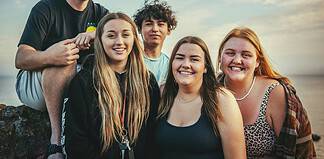Image: City of Greater Bendigo
BY EMMA DAVIES
THE next big gold discovery in Victoria could belong to anyone. Considering historical operations, Bendigo and Ballarat are set to benefit with a hive of exploration activity currently underway by juniors, like Chalice Gold.
Chalice Gold holds exploration licences over an area of more than 3000sqkm and is one of the largest junior players in the highly prospective north Bendigo zone – which hosts Kirkland Lake Gold’s Fosterville operation.
The company commenced drilling at its Pyramid Hill gold project in November 2018 and is focussed on testing the top 30m of basement rock on 3km spaced drill lines, looking for gold and pathfinder elements, which even at low levels can indicate proximity to large mineralised systems.
“Chalice has already drilled more drill holes into the target basement than all explorers before it,” Chalice Gold managing director Alex Dorsch told The Australian Mining Review.
“A surprising fact given our proximity to world-class gold deposits like Bendigo and Fosterville.”
Mr Dorsch said the company had high hopes for the Pyramid Hill gold project over the next few years.
“Our ambition is to make a globally significant, multi-million ounce gold discovery at the Pyramid Hill gold project in 2019,” he said.
“We truly believe this is a possibility, given the regional analogues such as Bendigo and Fosterville, as well as the strength of the targets we have defined.”
Regional Benefits
Should Chalice or another explorer make a discovery, there was likely to be significant positive impacts for the local community and wider Bendigo area.
Who could forget the flurry of activity following Fosterville’s resources upgrade from 1moz to 1.7moz in early 2018.
Bendigo mayor councillor Margaret O’Rourke said that there were a range of businesses that had historically provided machinery and other technology to support the mining sector.
“There are also various trades that would come in to maintain equipment, even down to catering and uniform companies that feed and clothe the industry and health and wellbeing providers that ensure worker safety,” Ms O’Rourke said.
Mining growth had created employment in the local communities and attracted new residents to live and work in the city.
“As a result, partners generally seek jobs in the local economy, they might buy a home, their children go to school nearby, they shop locally, seek out healthcare locally, play sport or enjoy a great range of recreation opportunities,” Ms O’Rourke said.
“To see these companies succeed delivers many flow-on benefits to Greater Bendigo’s economy, including to supporting industries and businesses.”
Ms O’Rourke said manufacturing was also a thriving industry in Bendigo – particularly for the mining industry.
“Our economy is valued at $7 billion. Unlike many parts of Australia and across the world, manufacturing, particularly the more specialised advanced manufacturing sector, is thriving here in Bendigo and is valued at $2.2 billion per annum,” she said.
“Employment in manufacturing in Bendigo, in contrast to most other areas, is virtually holding its levels.”
Investing in Exploration
Mr Dorsch said while there had been considerable gold mining in the State since the mid-1800s, exploration efforts had been quite limited in the past few decades.
“As such, services required for mineral exploration activities like drilling, laboratory testing and equipment hire are somewhat limited,” Mr Dorsch said.
“Chalice has utilised some local and some interstate service providers to conduct its activities.”
But the good news was that Victorian exploration expenditure was on the rise.
In 2016/17 it rose 40.8 per cent or $28.9 million to 40.7 million, according to the Australian Bureau of Statistics (ABS), and was growing at a higher rate than other States.
Between March and June 2018, exploration expenditure in Victoria increased 33 per cent – compared to just six per cent growth for all of Australia over the same period.
Late last year, the Andrews Labor Government extended the mining license for Fosterville gold mine out to 2035 and State Resources minister Tim Pallas flagged a further land release for minerals exploration north of Fosterville in an area with similar geology.
“This is a great result for the local economy and demonstrates the positive impact the resources industry can bring to our regional areas,” Mr Pallas said at the time.
“The extension of these licences is a boost to the Bendigo region, it’s great for jobs and allows the success story of these mines to continue.”
Balancing Act
Ms O’Rourke said that while mining was regulated through the State Government, it was the responsibility of mining companies to meet their obligations for respecting natural surrounds.
“Mining operations in the City of Greater Bendigo are largely in rural areas, so it can be a challenge for some rural residents who have chosen to live rurally but then come up against a mining expansion near to their property,” Ms O’Rourke said.
“The real challenge is when mining companies want to expand their operations.”
While Chalice was still in an early reconnaissance stage of exploration, Mr Dorsch said the aim was to minimise the company’s environmental footprint.
“We are capturing all drill waste, minimising dust and noise, and completely rehabilitating drilling sites – this is working exceptionally well, with almost non-existent remnants of our operations at rehabilitated drill holes,” Mr Dorsch said.
“Environmental impacts of a mine depend largely on the specifics of how the deposit will be mined, however as can be seen with modern operations like Fosterville, environmental impacts from mining can be managed effectively to minimise impact on the immediate community.”
Mr Dorsch said the company hoped to continue sustainable exploration and to fully define the size of its discovery with the aim to begin development activities in the next few years.
“The resurgence of the region, driven largely by Fosterville, is extremely positive for the industry and region,” he said.
“Chalice commenced exploration activities in mid-2018 and plans to be a long term player in this exciting gold district.”
PROJECTS IN FOCUS
- Pyramid Hill (Chalice Gold) | Exploration began at the gold project in 2018 with encouraging results to date.
- Ballarat Goldfield (Castlemaine Goldfields) | The active mine produces about 40,000oz of gold per annum and is one of the company’s five tenements in central Victoria.
- Costerfield (Mandalay Resources) | In January, Mandalay announced a 48 per cent increase in Proven and Probable Mineral Reserves for contained gold at its producing Costerfield mine.
- Fosterville (Kirkland Lake Gold) | The largest gold producer in Victoria, Fosterville, is 20km from Bendigo, and produced 124,307 ounces of gold in Q4 2018.
- Stawell (Arete Capital Partners) | Stawell mine is set to re-enter production in early 2019, recently employing 100 staff.
- Fingerboards (Kalbar Resources) | A Bankable Feasibility Study for this mineral sands project at Glenaladale, East Gippsland, was currently underway.
- Nagambie (Nagambie Resources) | The junior has identified four strong underground sulphide-gold targets at its Nagambie mine, (Nagambie, Nagambie North, Cahill and Racecourse) and was completing further exploration.
- Tandarra (Navarre Minerals and Catalyst Metals) | Navarre Minerals owns a 49 per cent share in this high-grade gold project in central Victoria with Catalyst Metals set to earn a 51 per cent equity interest by spending $3 million over four years to advance the project towards mineral resource status. Catalyst was also completing other exploration in the region.
- Yendon (Pure Alumina) |High-grade, low impurity kaolin deposits close to Ballarat, Victoria. A Definitive Feasibility Study was expected to be complete by Q3 2019.








































